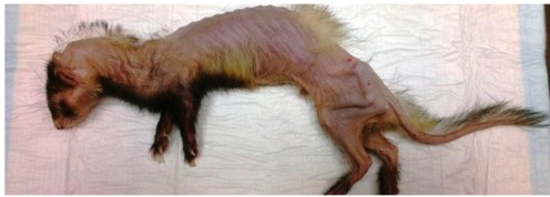Clinical Signs and Estradiol, Androstenedione and 17-α-Hydroxyprogesterone Measurements in Domestic Ferret (Mustela putorius furo) Diagnosed with Hyperadrenocorticism
A. Ilgaza; S. Grinblate
Preclinical Institute, Faculty of Veterinary Medicine, Latvia University of Agriculture, Jelgava, Latvia
Introduction
There are many research studies about hyperadrenocorticism in neutered male and female pet ferrets (Mustela putorius furo). It is considered that chronic elevation in circulating gonadotropins, predominantly luteinizing hormone (LH), that follows ovariectomy or orchiectomy, is a prerequisite for neoplastic transformation in the adrenal glands. Due to development of adrenal disease, several sex steroid levels increase and typical clinical signs are emerging.
Objectives
To summarize clinical findings and sex steroid levels in ferrets, presented in various veterinary clinics with clinical signs associated with hyperadrenocorticism and evaluate them.
Methods
Forty-two ferrets (n=20 female, n=22 male) with various clinical symptoms related to hyperadrenocorticism were included in this research. Clinical examination was performed and blood samples were collected. In blood samples levels of 17-α-hydroxyprogesterone, estradiol and androstenedione were detected.
Results
Blood sample results indicated abnormal hormonal levels in all animals. Nineteen ferrets had more than one sex steroid increased and 25 animals had elevated androstenedione levels. Results of clinical examination showed that main clinical signs were: alopecia, observed to all animals in various degrees; fragile skin; behavioral changes; weight loss; recurrence of sexual behavior; polyuria and polydipsia; pruritus and scaling
| Figure 1 | 
In individual animals numerous clinical signs were observed. Each ferret had 4–6 clinical signs. |
|
| |
Conclusions
Most common clinical signs were alopecia, pruritus and behavioral changes. Sex steroids - androstenedione, 17-α-hydroxyprogesterone, estradiol levels were abnormal in all animals, included in this research. We would like to point out that more than one hormone was increased in 20 cases (45%) of ferrets.